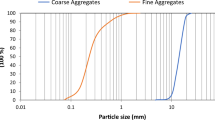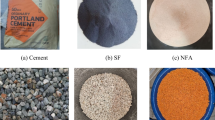Abstract
An experimental program was carried out to study the properties of concretes with C25/30 and C35/45 resistance classes designed using natural aggregates and recycled ones provided from construction and demolition waste (C&DW). Eight mixtures were prepared with different incorporation ratios of fine and coarse recycled aggregates. The physical and mechanical characteristics were measured and their evolution regarding to the paste volume, the equivalent replacement ratio and the quality of the interface between recycled aggregates and new paste has been investigated. Scanning Electron Microscopic observations have revealed a good quality of the interface. It was found that water porosity is more dependent on the equivalent replacement ratio than on the volume of the new paste. The same conclusions are reported for the electrical resistivity which has been related to the water porosity. Based on experimental results, it has been found that the Archie’s law predicts the electrical resistivity as a function of water porosity for all type of concrete. The effect of mix design parameters and aggregates properties on the compressive strength has been investigated and a model is proposed on the basis of Féret’s expression through experimental results and data points available in the literature. The modified expression is related to the aggregate fragmentation resistance expressed by the Los Angeles coefficient (LA). The Féret’s coefficient can be taken equal to 6.4 if LA ≤ 20% and it is inversely proportional to LA otherwise. With regard to the splitting tensile strength, it can be correlated to the electrical resistivity through a power law relationship. The elastic modulus, the peak and the ultimate strains are than rewritten as functions of the compressive strength and the replacement ratio to model the full stress–strain curve under uniaxial compression. Furthermore, the validity of using EC2 to model the evolution of all mechanical properties with age is ensured.
























Similar content being viewed by others
References
UNPG, Union Nationale des Producteurs de Granulats. http://www.unpg.fr/
UNICEM, L’Union nationale des industries de carrières et matériaux de construction. http://www.unicem.fr/
Tüfekçi MM, Çakır Ö (2017) An investigation on mechanical and physical properties of recycled coarse aggregate (RCA) concrete with GGBFS. Int J Civ Eng 1–15
de Juan MS, Gutirrez PA (2009) Study on the influence of attached mortar content on the properties of recycled concrete aggregate. Constr Build Mater 23(2):872–877
Casuccioa M, Torrijos MC, Giaccio G, Zerbino R (2008) Failure mechanism of recycled aggregate concrete. Constr Build Mater 22(7):1500–1506
Xiao J, Li J, Zhang C (2005) Mechanical properties of recycled aggregate concrete under uniaxial loading. Cem Concr Res 35(6):1187–1194
Dilbas H, Çakır Ö, Şimşek M (2017) Recycled aggregate concretes (RACs) for structural use: an evaluation on elasticity modulus and energy capacities. Int J Civ Eng 15(2):247–261
Kapoor K, Singh SP, Singh B (2016) Water permeation properties of self compacting concrete made with coarse and fine recycled concrete aggregates. Int J Civ Eng 1–10
Lotfy A, Al-Fayez M (2015) Performance evaluation of structural concrete using controlled quality coarse and fine recycled concrete aggregate. Cement Concr Compos 61:36–43
Evangelista L, de Brito J (2007) Mechanical behaviour of concrete made with fine recycled concrete aggregates. Cement Concr Compos 29(5):397–401
Wardeh G, Ghorbel E, Gomart H (2015) Mix design and properties of recycled aggregate concretes: applicability of Eurocode 2. Int J Concr Struct Mater 9(1):1–20
Ravindrarajah RS, Tam CT (1985) Properties of concrete made with crushed concrete as coarse aggregate. Mag Concr Res 37(130):29–38
Etxeberia M, Vaguez E, Mari A, Barra M (2007) ¨Influence of amount of recycled coarse aggregates and production process on properties of recycled aggregate concrete¨. Cem Concr Res 735(42):37
Rodríguez-Robles D, Moran-del Pozo JM, Garcia-Gonzalez J, Guerra-Romero MI, Juan-Valdés A (2015) Effect of mixed recycled aggregates on mechanical properties of recycled concrete. Mag Concr Res 67(5):247–256
Stutzman P, Heckert A, Tebbe A, Leigh S (2014) Uncertainty in Bogue-calculated phase composition of hydraulic cements. Cem Concr Res 61–62:40–48
Omary S, Ghorbel E, Wardeh G (2016) Relationships between recycled concrete aggregates characteristics and recycled aggregates concretes properties. Constr Build Mater 108:163–174
Gomez-Soberon JMV (2002) Porosity of recycled concrete with substitution of recycled concrete aggregate: an experimental study. Cem Concr Res 32(8):1301–1311
De Larrard F (1999) Concrete mixture proportioning: a scientific approach. Spon Press, London, Modern Concrete Technology, p 448
Brouwers HJH (2004) The work of powers and brouwnyard revisisted: Part 1. Cem Concr Res 34:1697–1716
Powers TC, Brownyard TL (1946) Studies of the physical properties of hardened portland cement paste. Am Concr Inst 43:469–504
Mills RH (1966) Factors influencing cessation of hydration in water Cured Cement Pastes. Trans Res Board 90:406–424. http://onlinepubs.trb.org/Onlinepubs/sr/sr90/90-034.pdf
Tennis PD, Jennings HM (2000) A model for two types of calcium silicate hydrate in the microstructure of Portland cement pastes. Cem Concr Res 30(6):855–863
Lin F, Meyer C (2009) Hydration kinetics modeling of Portland cement considering the effects of curing temperature and applied pressure. Cem Concr Res 39(4):255–265
Waller V (1999) Relations entre composition des bétons, éxothermie en cours de prise et résistance en compression. École Nationale des Ponts et Chaussées, p 297
Kou SH (2006) Reusing recycled aggregates in structural concrete. The Hong Kong Polytechnic University, p 312
Xiao L, Ren Z, Shi W, Wei X (2016) Experimental study on chloride permeability in concrete by non-contact electrical resistivity measurement and RCM. Constr Build Mater 123:27–34
Noort RV, Hunger M, Spiesz P (2016) Long-term chloride migration coefficient in slag cement-based concrete and resistivity as an alternative test method. Constr Build Mater 115:746–759
Liu Z, Zhang Y, Liu L, Jiang Q (2013) An analytical model for determining the relative electrical resistivity of cement paste and C–S–H gel. Constr Build Mater 48:647–655
Ma H, Hou D, Li Z (2015) Two-scale modeling of transport properties of cement paste: formation factor, electrical conductivity and chloride diffusivity. Comput Mater Sci 110:270–280
Archie G (1942) The electrical resistivity log as an aid in determining some reservoir characteristics. Trans Am Inst Min Metal Eng 146:54–62
Eurocode2 (2004) Design of concrete structures_Part 1-1 General rules and rules for buildings. Paris
Feret R (1892) Sur la compacité des mortiers. Ann Ponts Chaussées Sér 7(4):5–164
Boukli Hacene SMA, Ghomari F, Schoefs F, Khelidj A (2009) Etude expérimentale et statistique de l’influence de l’affaissement et de l’air occlus sur la résistance à la compression des bétons. Leban Sci J 10:81–100
Júlio E, Dias N, Lourenço J, Silva J (2006) Feret coefficients for white self-compacting concrete. Mater Struct 39:585–591. doi:10.1007/s11527-005-9048-x
Çakir Ö (2014) Experimental analysis of properties of recycled coarse aggregate (RCA) concrete with mineral additives. Constr Build Mater 68:17–25
Tuyan M, Mardani-Aghabaglou A, Ramyar K (2014) Freeze-thaw resistance, mechanical and transport properties of self-consolidating concrete incorporating coarse recycled concrete aggregate. Mater Des 53:983–991
Chakradhara RM, Bhattacharyya S, Barai S (2011) Influence of field recycled coarse aggregate on properties of concrete. Mater Struct 205–220
Thomas C, Setién J, Polanco JA, Alaejos P, de Juan MS (2013) Durability of recycled aggregate concrete. Constr Build Mater 40:1054–10655
Manzi S, Mazzotti C, Bignozzi MC (2013) ¨Short and long-term behavior of structural concrete with recycled concrete aggregate¨. Cement Concr Compos 37:312–318
Kou S-C, Poon C-S (2013) Long-term mechanical and durability properties of recycled aggregate concrete prepared with the incorporation of fly ash. Cement Concr Compos 37:12–19
Correia JR, de Brito J, Pereira AS (2006) Effects on concrete durability of using recycled ceramic aggregates. Mater Struct 39(2):169–177
Belén G-F, Fernando M-A, Diego CL, Sindy S-P (2011) Stress-strain relationship in axial compression for concrete using recycled saturated coarse aggregate. Constr Build Mater 25(5):2335–2342
Malesev M, Radonjanin V, Marinkovic S (2010) Recycled concrete as aggregate for structural concrete production. Sustainability 2(5):1204–1225
Ajdukiewicz AB, Kliszczewicz AT (2007) Comparative tests of beams and columns made of recycled aggregate concrete and natural aggregate concrete. Adv Concr Technol 5(2):259–273
Ignjatovic IS, Marinković SB, Miskovic ZM, Savić A (2013) Flexural behavior of reinforced recycled aggregate concrete beams under short-term loading. Mater Struct 46:1045–1059. doi:10.1617/s11527-012-9952-9
Kou S-C, Poon C-S, Etxeberria M (2011) Influence of recycled aggregates on long term mechanical properties and pore size distribution of concrete. Cement Concr Compos 33(2):286–291
Breccolotti M, Materazzi AL (2010) Structural reliability of eccentrically-loaded sections in RC columns made of recycled aggregate concrete. Eng Struct 32(11):3704–3712
Kim J-K, Kim Y-Y (1996) Experimental study of the fatigue behavior of high strength concrete. Cem Concr Res 26(10):1513–1523
Butler L, West JS, Tighe SL (2011) The effect of recycled concrete aggregate properties on the bond strength between RCA concrete and steel reinforcement. Cem Concr Res 41(10):1037–1049
Bairagi NK, Ravande K, Pareek VK (1993) Behaviour of concrete with different proportions of natural and recycled aggregates. Resour Conserv Recycl 9(1–2):109–126
Xiao J, Sun Y, Falkner H (2006) Seismic performance of frame structures with recycled aggregate concrete. Eng Struct 28(1):1–8
Cabral AEB, Schalch V, Molin DCCD, Ribeiro JLD (2010) Mechanical properties modeling of recycled aggregate concrete. Constr Build Mater 24(4):421–430
Aslani F, Nejadi S (2012) Mechanical properties of conventional and self-compacting concrete: an analytical study. Constr Build Mater 36:330–347
Etxeberria M, Vazquez E, Mari A, Barra M (2007) Influence of amount of recycled coarse aggregates and production process on properties of recycled aggregate concrete. Cem Concr Res 37(5):735–742
Thomas Kang H-K, Kim W, Kwak Y-K, Hong S-G (2014) Flexural testing of reinforced concrete beams with recycled concrete aggregates. ACI Struct J 111(3):607–613. doi:10.14359/51686622
De Oliveira MB, Vazquez E (1996) The influence of retained moisture in aggregates from recycling on the properties of new hardened concrete. Waste Management Bulk Inert Waste: an Opportunity for Use 16(1–3):113–117
Mohamed MA (2011) Influence de la valorisation de microfibres végétales sur la formation et la résistance aux cycles de gel-dégel de BAP. Ph.D. thesis, University of Cergy-Pontoise, p 272
Domingo-Cabo A, Lazaro C, Lopez-Gayarre F, Serrano-Lopez MA, Serna P, Castano-Tabares JO (2009) Creep and shrinkage of recycled aggregate concrete. Constr Build Mater 23(7):2545–2553
Fathifazl G, Razaqpur AG, Isgor OB, Abbas A, Fournier B, Foo S (2009) Flexural performance of steel-reinforced recycled concrete beams. ACI Struct J 106(6):858–867
Breccolotti M, D’Alessandro A, Roscini F, Bonfigli MF (2015) Investigation of stress–strain behaviour of recycled aggregate concrete under cyclic loads. Environ Eng nd Manag J 14(7):1543–1552
Carreira JD, Chu K-H (1985) Stress–Strain Relationship for Plain Concrete in Compression. ACI J 72-82
Prasad MLV, Kumar PR, Oshima T (2009) Development of analytical stress–strain model for glass fiber reinforced self compacting concrete. Int J Mech Solids 4(1):25–37
Wee T, Chin M, Mansur M (1996) Stress–Strain relationship of high-strength concrete in compression. J Mater Civ Eng 8(2):70–76
Hognestad E A study of combined bending and axial load in reinforced concrete members, in University of Illinois Engineering Experiment Station. U. Urbana (BOOK: IL, Bull. no. 399, Editor. 1951)
Desayi P, Krishnan S (1964) Equation for the stress–strain curve of concrete. ACI J 61(3):345–350
Mazars J, Pijaudier-Cabot G (1989) Continuum damage theory Application to concrete. ASCE Eng Mech 115(2):345–365
Kumar R, Singh B, Bhargava P (2011) Flexural capacity predictions of self-compacting concrete beams using stress–strain relationship in axial compression. Mag Concr Res 36(1):49–59
Acknowledgements
The authors wish to acknowledge the French national research agency (ANR) for funding support.
Author information
Authors and Affiliations
Corresponding author
Rights and permissions
About this article
Cite this article
Omary, S., Ghorbel, E., Wardeh, G. et al. Mix Design and Recycled Aggregates Effects on the Concrete’s Properties. Int J Civ Eng 16, 973–992 (2018). https://doi.org/10.1007/s40999-017-0247-y
Received:
Revised:
Accepted:
Published:
Issue Date:
DOI: https://doi.org/10.1007/s40999-017-0247-y




